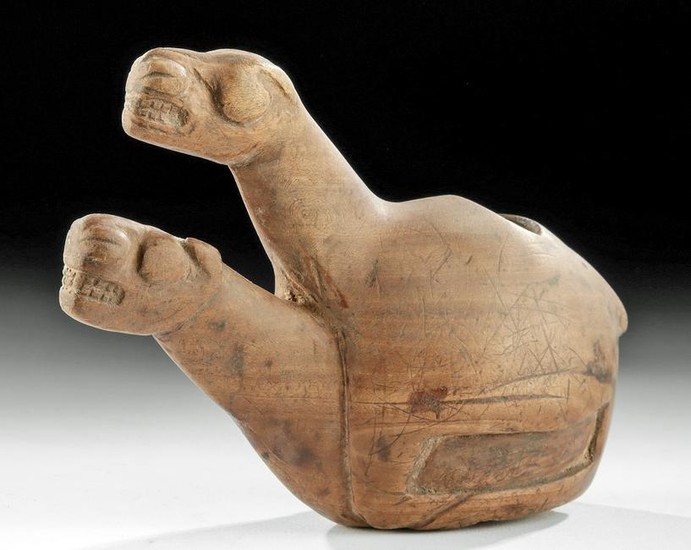Rare Inca Wood Canopa - Mating Llamas
Pre-Columbian, Central Peru, Inca Empire, ca. 1200 to 1532 CE. A rare, well-preserved, hand-carved wood canopa, in the form of two mating camelids, with a round but stable base and hollowed-out interior. There are nice details on the faces and bodies of the camelids including relief mouths. Small wooden vessels like this one are the most common ritual effigies known from the Inca Empire. Typically depicting llamas, alpacas, or other camelids, canopas are often buried in the animals' corrals to protect the herds and symbolically increase their fertility. The cavity on the back of each vessel would have been filled with offerings like coca leaves, maize, or animal fat in order to appease the gods. This example is made from a type of wood called kishuar (kiswar), an ancient, high elevation Peruvian tree, that was also used medicinally by the Inca. Size: 5.75" W x 3.85" H (14.6 cm x 9.8 cm)
Provenance: ex-Leonard Lyle Dees collection, Topeka, Kansas, USA, acquired between 1950 and 1970
All items legal to buy/sell under U.S. Statute covering cultural patrimony Code 2600, CHAPTER 14, and are guaranteed to be as described or your money back.
A Certificate of Authenticity will accompany all winning bids.
We ship worldwide to most countries and handle all shipping in-house for your convenience.
#148157
Condition Report: Intact, with rich patina from age and handling. Light scratching commensurate with age and use.
View it on
Estimate
Time, Location
Auction House
Pre-Columbian, Central Peru, Inca Empire, ca. 1200 to 1532 CE. A rare, well-preserved, hand-carved wood canopa, in the form of two mating camelids, with a round but stable base and hollowed-out interior. There are nice details on the faces and bodies of the camelids including relief mouths. Small wooden vessels like this one are the most common ritual effigies known from the Inca Empire. Typically depicting llamas, alpacas, or other camelids, canopas are often buried in the animals' corrals to protect the herds and symbolically increase their fertility. The cavity on the back of each vessel would have been filled with offerings like coca leaves, maize, or animal fat in order to appease the gods. This example is made from a type of wood called kishuar (kiswar), an ancient, high elevation Peruvian tree, that was also used medicinally by the Inca. Size: 5.75" W x 3.85" H (14.6 cm x 9.8 cm)
Provenance: ex-Leonard Lyle Dees collection, Topeka, Kansas, USA, acquired between 1950 and 1970
All items legal to buy/sell under U.S. Statute covering cultural patrimony Code 2600, CHAPTER 14, and are guaranteed to be as described or your money back.
A Certificate of Authenticity will accompany all winning bids.
We ship worldwide to most countries and handle all shipping in-house for your convenience.
#148157
Condition Report: Intact, with rich patina from age and handling. Light scratching commensurate with age and use.



